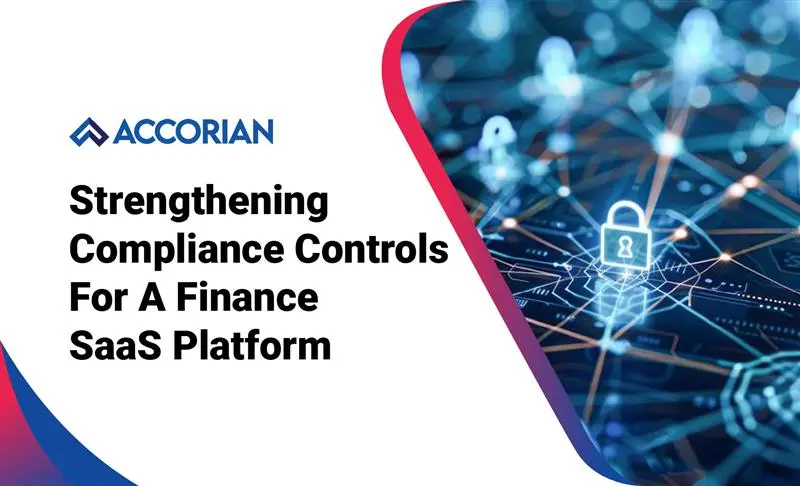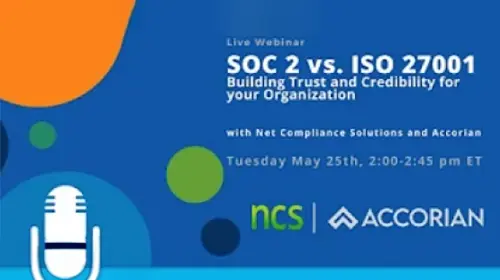SOC 2
The average cost of a data breach has risen by 15.3%, reaching $4.45 million.
SOC 2 (System and Organization Controls 2) is an AICPA compliance methodology that assesses how firms handle customer data based on five trust service criteria: security, availability, processing integrity, confidentiality, and privacy. SOC 2 is intended for cloud-based and technology organizations, and it uses third-party audits to demonstrate a commitment to data security and operational excellence. Accorian specializes in SOC 2 compliance, with skilled auditors conducting thorough assessments, identifying gaps, and installing essential controls. Our Type 1 and Type 2 SOC 2 reports assure strong security measures, increasing market value and giving clients a competitive advantage by ensuring suitable controls is in place to secure data and systems.
Why Do You Need SOC 2?
The SOC 2 (System and Organization Controls) reports play a vital role in demonstrating an organization’s compliance with the Trust Services Criteria (TSC) established by the American Institute of Certified Public Accountants (AICPA). These reports assure clients and stakeholders that the organization has implemented adequate controls to safeguard the Security, Availability, Processing Integrity, Confidentiality, and Privacy of their systems and data. Hence serving as an important tool to showcase the organization’s commitment to protecting sensitive information and meeting regulatory requirements.
Importance of SOC 2 Attestation?
Table Stakes
As security takes center stage for organizations, Managed Service Providers (MSPs) recognize the strategic advantage gained by certifying their commitment to security through SOC 2.
Customer Request/Meeting Client Demands
Clients are increasingly demanding their service & platform providers to provide a level of security assurance or certification, such as SOC 2, to substantiate their security and privacy claims.
Bolstering Trust & Enhancing Security
Optimizes efficiency by expediting vendor security survey and prospect questionnaire completion while providing comprehensive risk management insights to organizational management.
Accelerated Market Growth
Leveraging SOC 2 attestation exhibits your business’s commitment to robust security practices, unlocking lucrative opportunities and enabling MSPs to strategically market security-focused solutions to existing clients
for long-term growth.
Continuous Improvement
SOC 2 establishes baseline controls, secures your environment, and enables annual control efficacy testing.
The SOC 2 audit or report is a way to assure your clients that your environment has a basic set of information security controls in place. It verifies that the IT controls of an organization are correctly aligned, developed, and implemented to fulfill the performance criteria.
A SOC 2 report is made to fit the needs of each organization. Based on its business practices, each organization can develop controls centered around one or more trust principles.
Got SOC 2 Attested?
Then You're Almost Compliance Ready
Got SOC 2 Attested? Then You're Almost Compliance Ready
Types of SOC 2 Reports
01
Type I Report
Suitable for companies that are in the process of implementing their security framework and controls for the first time. The Type 1 report represents a point-in-time assessment and does not evaluate control maturity.
02
Type II Report
Suitable for companies with established security controls over a period of typically 6 months. The auditor assesses control maturity, evaluates the effectiveness, and consistency of controls, demonstrating an ongoing commitment to security and compliance.
Download SOC 2 Guide
Methodology of Achieving Your SOC 2 Report
Scoping
- Defining and finalizing the optimum scope
- Defining the TSCs
- Identifying the systems, processes, & controls relevant to your organization
- Finalizing the scope
Gap Assessment
- Understanding the current state of your SOC 2 compliance
- Conducting a thorough assessment of the current security practices, policies, and controls against the requirements of the SOC 2 framework
- Identifying current gaps and implementing the security measures to ensure compliance with the relevant TSCs
- Providing a prioritized remediation plan
Remediation Advisory
Remediation advisory via calls to aid in addressing queries
Remediation
Implementing of corrective measures by your team to resolve the identified errors/deficiencies and improve the overall security posture of the client
Pre-Audit
Ensuring the organization is ready for the formal audit and attestation to be conducted by our AICPA-accredited CPA firm
Audit & Attestation
SOC 2 audit conducted by Accorian Assurance:
Type 1: Point in time
Type 2: 4+ months steady control state
Issuing of a SOC 2 report summarizing the findings, including the organization's control environment and effectiveness in meeting the defined criteria
Who Should Get SOC 2?
SOC 2 reports are often required for service firms across industries that store, process, or transfer sensitive data for their clients. We serve a diverse portfolio of industries, including:
Technology and Cloud Computing Entities
Virtual Currency Service Providers
Managed IT Service Providers
Data Centers
SaaS Providers
Web-Hosting Service Providers
Processors of Payrolls and Medical Claims
The SOC 2 Trust Services Criteria (TSCs)
The SOC 2 Trust Services Criteria (TSCs) provide comprehensive framework for scoping, developing, implementing, and evaluating information system controls. These controls are essential to ensure that your information system can effectively achieve its objectives. SOC 2 examines five key Trust Services Criteria to secure data processing and storage:
Security
Ensuring protection against intrusion and risks that could compromise service delivery
Availability
Demonstrating consistent and accessible systems for uninterrupted service, ensuring the organization’s systems are available and accessible to users
Confidentiality
Protecting sensitive data from unauthorized access or disclosure
Processing Integrity
Ensuring accurate and reliable data processing techniques
Privacy
Responsibly managing personally identifiable information (PII) in compliance with privacy laws
Integration Of Other Frameworks
We can combine your SOC 2 report with other projects to avoid audit exhaustion. We can even produce a single report that includes HITRUST, ISO 27001/27002, HIPAA, and other standards using our knowledge of diverse frameworks.
To prepare your organization to handle today’s rising compliance demands, our team will bring together risks, controls, policies, frameworks, challenges, and more.
Why Choose Accorian?
Accorian is a leading cybersecurity firm specializing in providing comprehensive services to help companies achieve and maintain SOC 2 compliance. Our team of auditors with extensive technical backgrounds and expertise in data security possess the capability to conduct thorough assessments of your organization’s system and controls.
Our audit professionals are skilled in preparing Type 1 and Type 2 reports for SOC 2 audits. This includes conducting gap assessments, identifying necessary controls, and implementing them on behalf of your service business.
We can help enhance your marketplace value with effective privacy and security measures, giving you a competitive edge.
Accorian’s SOC 2 services are effective in enhancing the security, availability, confidentiality and privacy requirements of organizations. We evaluate your systems for compliance, locate security weaknesses and suggest measures to address those weaknesses – all for the purpose of ensuring data protection and building confidence with client’s expectations.




